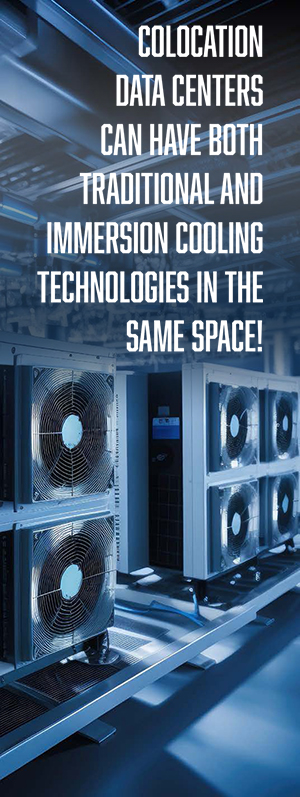
In early September 2023, Forbes reported that AI and liquid cooling are the future of data center development. While at nearly the same time Fortune mentioned that AI fueled a 34% increase in Microsoft’s water consumption at their AI data center in Iowa and now citizens are concerned about the effect on the residential supply of water. Clearly, finding solutions for more efficient and effective cooling for data centers is quickly growing from an “inside industry” issue to one that is making its way to Main Street.
Colocation data center providers have been supplying the market with the space for their data-driven needs using traditional methods, such as air-cooled chillers, to cool vertical rack systems down to 67 degrees F. In some circumstances even down to 50 degrees F to avoid hot spots from a high density of server racks with intense computing power. Given the heat that the equipment is generating, 130+ degrees F, this takes a great deal of energy to lower the spaces to optimal operating temperatures.
With immersion cooling, which places components side by side in a sealed cabinet and then submerges them in a liquid substance (generally mineral oil-based), cooling temperatures can be maintained at a much higher levels – over 100 degrees F in some cases. Heat is directly transferred into the cooling fluid as opposed to being transferred into air which is then transferred into a cooling fluid. So, if the temperature of the liquid when it passed over the equipment raises to 130 degrees when it goes to the chiller or fluid cooler, it only has 27-30 degrees to drop versus room air cooled methods that must reduce it 60 degrees or more. The cost savings are immense – it can reduce data center operating costs by more than 90% and capital expenses by more than 50%(1) . Additionally, since the fluid is much more effective at conducting heat than air, it requires less space for distribution within the white space, which allows for greater space to accommodate these high power servers.
Why isn’t everyone using it? While immersion cooling is not particularly new – most current applications trace back to start-ups from 2017(2), it is still considered to be in the early adopter phase. Most use has been from big tech companies, or hyper-scalers, who are building their own massive data centers like Amazon Web Services (AWS), Microsoft Azure and Google Cloud who have the funding to explore alternative technologies for cooling and space conservation.
Now, with the explosion of AI in niche markets and analysts predicting that “the technology will be mainstream within the next four years – growing from $251 million in 2021 to over $1.6 Billion by 2027”(3), colocation providers can see that the shift is coming. Many are already starting to see demand for alternative cooling methods, especially as load density increases (+50kW per cabinet). Forward thinking developers are looking at their spaces to understand if they can create a hybrid environment that allows them to provide immersion technologies alongside legacy technologies, without having to replace their entire operation. The short answer is they can, with the proper analysis of current capacities and infrastructure, and development of tailored designs specifically for dual cooling capabilities with provisions for conversion and scale up in the future to accommodate these new technologies.
Practical Considerations for Creating a Hybrid Data Center Space may include:
1. Hybrid Cooling Plants: Scalable plants that utilize a combination of fluid coolers and chillers.
2. Flexible Distribution Loops:
3. Flexible White Space:
Profit margins for Colocation developers are currently being heavily impacted by large cloud providers who “do it all” and by providing the option of immersion cooling to tenants they will be able to charge a premium for a portion of their available space, without displacing current tenants who do not have that need … yet. As the demand for immersion cooling options grow, they can expand that space footprint to accommodate new installations and eventually convert fully if the need dictates. Meanwhile, they will also have a marketing advantage with prospective tenants to show they are staying on the cutting edge of data center development. When considering this option, it is important to engage engineers who are fluent in the considerations for a hybrid data center to achieve a successful transition of the facility.
As the demand for more efficient cooling systems continues to grow as a result of higher load densities to support AI, immersion cooling technologies will become more prevalent and cost effective resulting in more deployments by a wider range of colocation developers and enterprise data centers throughout the industry.
(1) “How Immersion Cooling is Changing Data Center Density and Design” – Bill Kleyman – Data Center Frontier – 6/27/2023
(2) “The Immersion Cooling Technology: Current and Future Development in Energy Saving” – Nugroho Agung Pambudi, Alfan Sarifundin, Ridho Ahfan Firdaus, Desite Damily Ulfa, Indra Mamad Gandidi, Rahmat Romadhon – 2/26/2022
(3) “AI, Liquid Cooling and the Date Center of the Future” – Holland Barry – Forbes – 9/11/2023
Scott Davis, PE is VP & Director of Mechanical Engineering at Bala Consulting Engineers, Inc. He can be reached at [email protected].